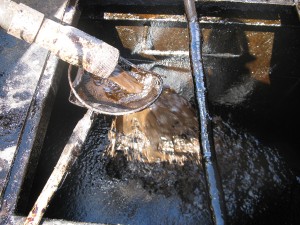
By Seth Whitehead, EnergyInDepth
The National Geographic Voices Blog published a story by the International League of Conservation Photographers (iLCP) this week aimed at stoking fears over unfounded claims that volatile organic compound (VOC) emissions from shale development pose a threat to public health.
Considering the piece was authored by a “reporter” from the Environmental Integrity Project — which receives funding from the anti-fracking Park Foundation and was responsible for a 2014 report that incorrectly claimed wells were being fracked with diesel — it comes as no surprise the story’s claims are not only based entirely on the anecdotal accounts of an anti-fracking activist, but also completely ignores the fact that the story’s central claim has been completely debunked.
The story centers on anti-fracking activist Jane Worthington, who claims that her daughter has suffered numerous ailments attributable to benzene exposure at Fort Cherry School due to its close proximity to shale development. To their credit, the Environmental Integrity Project reporter does note that Worthington has “become a locally well-known anti-fracking activist.” But the story does not mention that a study commissioned by the Fort Cherry school board found no adverse impacts from shale development taking place nearby.
The study took continuous air measurements at the school and a residence — both located 900 meters from the drilling site — before, during and following fracking operations over a three-month timespan in 2011 and 2012, concluding,
“The primary finding of this study was that the presence and operation of a hydraulic fracturing well pad in Washington County, PA, did not substantially affect local air concentrations of total and individual VOCs…”

More specifically, emissions collected during development operations were similar to the baseline levels (i.e., before fracking). From the study,
“Total and individual VOC concentrations measured during fracturing and flaring operations did not demonstrate a notable difference from concentrations measured prior to fracturing or after flaring ended.”
As the following graphic from the study illustrates, VOC emission levels were actually much higher at the school site (site “A,” highlighted in yellow) before and after fracturing and flaring operations than they were while fracking and flaring operations were being conducted.
The study even states “… the data for site A showed that the average 24-hour TVOC concentrations were markedly lower during the fracturing and flaring periods; thus, as source unrelated to the well pad activities is likely to be responsible,” speculating vehicle exhaust could be the cause.
Also, the VOCs detected, benzene included, were consistent with background levels. From the study,
“Several individual volatile compounds were detected in the 24-hour samples, but they were consistent with background atmospheric levels measured previously at nearby sampling sites in other areas in Washington County.”
As the following graphic from the study illustrates, emissions detected at the sampling sites were right in line with (and in some cases lower) than a pair of background locations (highlighted in yellow) that are not close to shale development.
VOCs detected were also below health protective levels. From the study,
“Furthermore, a basic yet conservative screening level evaluation demonstrated that the detected volatile organic compounds were well below health-protective levels.”
The area highlighted in yellow from the following table taken from the study shows United States Environmental Protection Agency (EPA) Regional Screening Level (RLS) limits. None of the VOC levels detected exceeded RSL health protective limits.
The above tables from the study also show no elevated levels of benzene, which completely contradicts the story’s claims that problems are attributable to benzene exposure from period when wells were being actively drilled near the school.
The story also suggests that fracking is to blame for Worthington’s daughter having asthma, another favorite claim of anti-fracking activists.
But as EID has recently noted, there is no evidence linking fracking to causing asthma or increased asthma exacerbations. Washington County’s 2013 asthma hospitalization rate (13.7 per 10,000) is actually lower than the state rate, according to Pennsylvania Department of Health data, and asthma hospitalization rates in Pennsylvania have actually declined from 19.2 per 10,000 a year to 14.2 per 10,000 between 2009 and 2013 — which just so happens to be the time the shale boom really took off.
This is partially because increased use of natural gas has dramatically reduced a number of criteria pollutants that can trigger asthma attacks — PM. 2.5, specifically — which is why Democratic presidential nominee Hillary Clinton released a factsheet this year touting that fracking prevented “100,000 asthma attacks in 2015 alone.”

This study is just one of many conducted both in the Marcellus and elsewhere that have taken actual air measurements near well sites and shown that emission levels are protective of public health, including:
- A recent study led by researchers at Drexel University found low levels of air emissions at well sites in the Marcellus region. As they explained, “we did not observe elevated levels of any of the light aromatic compounds (benzene, toluene, etc.)” and “there are few emissions of nonalkane VOCs (as measured by PTR-MS) from Marcellus Shale development.”
- A study by Professional Service Industries, Inc., commissioned by Union Township in Pennsylvania found “Airborne gas and TVOC levels appear to have been at or near background levels for the entire monitoring periods in the three locations monitored.”
- A study on emissions in the Barnett Shale by the Houston based ToxStrategies concluded that there is no credible health risk associated with shale development. As the researchers noted: “The analyses demonstrate that, for the extensive number of VOCs measured, shale gas production activities have not resulted in community-wide exposures to those VOCs at levels that would pose a health concern.”
- The Texas Commission on Environmental Quality conducted months of testing in the Barnett Shale region of North Texas, and its samples showed “no levels of concern for any chemicals.” TCEQ added that “there are no immediate health concerns from air quality in the area.”
- A report by the West Virginia Department of Environmental Protection found no major health threat from shale. According to that report: “Based on a review of completed air studies to date, including the results from the well pad development monitoring conducted in West Virginia’s Brooke, Marion, and Wetzel Counties, no additional legislative rules establishing special requirements need to be promulgated at this time.”
- The Colorado Department of Public Health installed air quality monitors at a well site that activists had complained about. CDPHE concluded: “The monitored concentrations of benzene, one of the major risk driving chemicals, are well within acceptable limits to protect public health, as determined by the U.S. Environmental Protection Agency. The concentrations of various compounds are comparatively low and are not likely to raise significant health issues of concern.”
- A study by the Texas Department of State Health Services used incorporated testing of individuals’ blood samples to see if there was a relationship between air emissions and poor health. The researchers concluded there was no connection.
- A recent study by the Barnett Shale Energy Education Council (BSEEC) looked at five Barnett wells in Mansfield, Tex., during both hydraulic fracturing (“fracking”) and flowback activities. The report measured volatile organic compounds (VOCs) and other emissions, and concluded “none of the observed VOCs were noted above the comparison criteria.”
- The Pa. DEP conducted air monitoring northeast Pennsylvania and concluded that the state “did not identify concentrations of any compound that would likely trigger air-related health issues associated with Marcellus Shale drilling activities.” A similar report for southwestern Pennsylvania came to the same conclusion.
- A peer-reviewed study looking at cancer incidence rates in several Pennsylvania counties found “no evidence that childhood leukemia was elevated in any county after [hydraulic fracturing] commenced.”
- A report by Public Health England (PHE), an executive agency of the UK’s Department of Health, concluded: “The currently available evidence indicates that the potential risks to public health from exposure to the emissions associated with shale gas extraction are low if the operations are properly run and regulated.”
- The Ministry of Health in British Columbia, Canada recently released a report which found that public health risks from shale development are very low. As the assessment concludes, “The overall findings of the detailed HHRA of oil and gas activity in NE BC suggest that, while there is some possibility for elevated COPC [chemicals of potential concern] concentrations to occur at some locations, the probability that adverse health impacts would occur in association with these exposures is considered to be low.”

Ironically, the story also notes that Worthington has a job that was directly created by shale development, but then turns right around and downplays the economic impact fracking has made in Washington County,
“The job creating aspect of fracking is part of the equation, and it has to be part of the dialogue, but slick public relations people and heavily funded lobby groups have inflated the impact of jobs on the local community while successfully cloaking, almost entirely, the serious health and environmental risks.”
Again, the facts debunk both claims.
A recent Washington & Jefferson College Center for Energy Policy and Management study found that Washington County has “decreased its unemployment rate by 50 percent between 2010 and 2014,” which coincided directly with shale development taking off. As EID detailed in April 2015, the study found that in Washington County between 2011 and 2013,
- “The total county economic output impact increased from approximately $1.7 billion to $2.4 billion, which represents 15% to nearly 20% of total county output during those years.” (Pg. 4)
- “The total labor force impact expanded from approximately 8,000 to more than 10,000, which is equivalent to 7% to 9% of total county employment. (Pg. 4)
- “The total state and local tax revenue impact increased from around $90 million to $160 million.” (Pg. 4)
- “The governments of Washington County and its municipalities received more than $24 million in impact fees, and the county received over $900,000 in Marcellus Legacy Fund distributions and over $10 million in lease/royalty payments during 2011- 2013.” (Pg. 5)
- “The total number of shale wells spudded during the three year period in Washington County represented 9%, 14.4%, and 18.2% of the total number of wells spudded in Pennsylvania respectively, reflecting the growing role of Washington County in Pennsylvania’s shale resource development.” (Pg. 5)
- “In addition to total output and employment, shale drilling activities indicated association with other economic activities of Washington County which is reflected in the following economic indicators: income from rents, royalties, patents, and copyrights, hotel occupancy tax revenue, housing prices, real estate tax revenue, sales tax revenue, and financial service activities. “ (Pg. 5)
The tone and complete disregard for the facts presented in this article are no shock, considering National Geographic was responsible for a similarly fictional account of North Dakota shale development in its recent “Fracking Hell” episode of its Underworld Inc. series.
This story was predictably trumpeted by card-carrying members of the anti-fracking echo chambers such as Food & Water Watch and the Sierra Club, but the facts show that shale development is not only protective of public health, but has provided economic opportunity for Washington County and Pennsylvania as a whole — Mrs. Worthington included.
Originally posted at EnergyInDepth on Nov. 18, 2016




